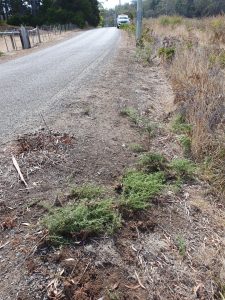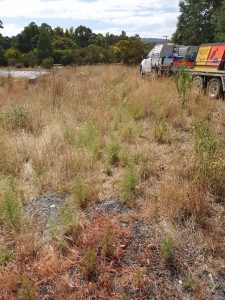Click below to find out more information about Kingborough Councils WEED OF THE MONTH.
KC WEED OF THE MONTH - AUGUST - BONESEED
Click to download information flyer –>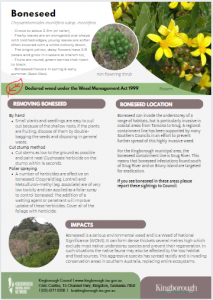
Name of weed?
Chrysanthemoides monilifera subsp. monilifera (Boneseed)
Status
Declared weed under the Biosecurity Act 2019
CHARACTERTISTICS OF BONESEED
What does it look like?
Boneseed is a woody shrub growing to 3 metres with elongated leathery leaves. It flowers from late-winter and produces yellow flowers in clusters. The round fleshy fruit turn black when mature and contain a single smooth seed. The seed is bone coloured when dry, hence the name ‘boneseed’.
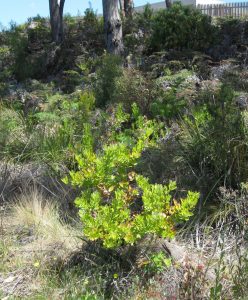
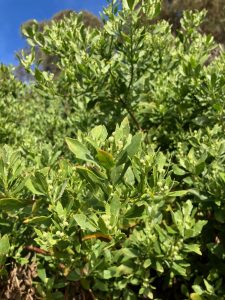
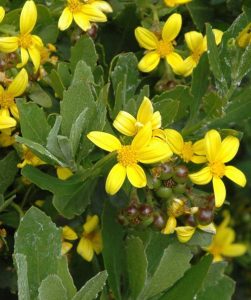
Why is it a problem?
Boneseed is a serious environmental weed and is a Weed of National Significance (WONS). It can form dense thickets several metres high which exclude most native understorey species and prevent their regeneration. In such situations the native fauna may also be affected by the loss habitat and food sources. This aggressive species has spread rapidly and is invading conservation areas in southern Australia, replacing entire ecosystems.
Where are you likely to see it?
Boneseed can invade the understorey of a range of habitats, but is particularly invasive in coastal areas from Taroona to Snug. A regional containment line has been supported by many Southern Councils in an effort to prevent further spread of this highly invasive weed. For the Kingborough municipal area, the boneseed containment line is Snug River. This means that boneseed infestations found south of Snug River and on Bruny Island are targeted for eradication.
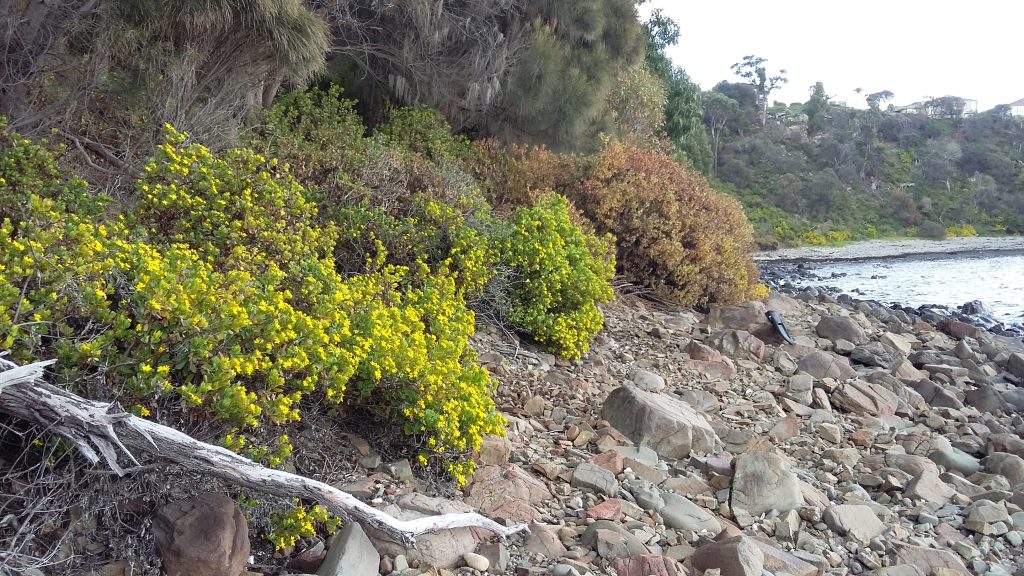
If you see boneseed in these areas please report these sightings to Council at kc@kingborough.tas.gov.au or 03 6211 8200.
METHODS FOR REMOVING BONESEED?
By hand
Small plants and seedlings are easy to hand pull due to their shallow roots. If the plants have seeds, dispose of them by double-bagging the seed heads and disposing in general waste only, not green waste. Alternatively, plants can be left on site to break down.
Cut stump method
Cut stems as low to the ground as possible and paint neat Glyphosate herbicide on the stump within 15 seconds.
Foliar spraying
A number of herbicides are effective on boneseed. Clopyralid (eg. Lontrel) and Metsulfuron-methyl (eg. Associate) are of very low toxicity and can applied as a foliar spray to control boneseed. The addition of a wetting agent or penetrant will improve uptake of these herbicides. Cover all of the foliage with herbicide.
What is Council doing to control boneseed?
Boneseed is a weed which is targeted south of Snug River and on Bruny Island. In working towards this, Council controls boneseed using a number of methods, including cut and paint, targeted spraying and manual removal. When boneseed is identified on other land tenures, including private land, landowners are notified and advised of best practice control methods. Where necessary, Council will enforce the Biosecurity Act 2019 and require landowners to control boneseed infestations.
North of Snug River, where boneseed is widespread and abundant, infestations are prioritised to ensure the most cost effective and efficient use of Council resources. Prioritisation is based on a number of factors, such as the size of infestations, proximity to areas of high natural values, such as bushland reserves or threatened species, and other criteria, such as impact on fire regime, recreational or aesthetic values.
There has been an in increase in community concern surrounding boneseed, particularly where infestations are highly visible, such as alongside the steep walking tracks and cliffs when viewed from our shorelines. Unfortunately, these areas are often the hardest to access and control.
In June 2023, after 15 years of successful on ground management of boneseed in the adjacent coastal reserves, Council was able to identify and secure a contractor that has the technology and capability to tackle invasive weeds in hard to access areas. Drone technology was employed to accurately target boneseed on the steep cliffs next to the Suncoast Headlands and Boronia Beach Track. Substantial investment into contracting this new technology demonstrates Council’s commitment to the management of this invasive species for the protection of our natural areas.
For more information about Paterson’s Curse and removing it using herbicides, visit Department of Primary Industries, Parks, Water and Environment’s website: Boneseed | Department of Natural Resources and Environment Tasmania (nre.tas.gov.au)
KC WEED OF THE MONTH - SEPTEMBER - WATER HEATH
Click to download information flyer –>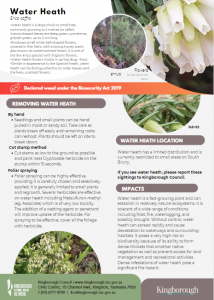
Name of weed?
Erica caffra (Water heath)
Status
Declared weed under the Biosecurity Act 2019
CHARACTERISTICS OF WATER HEATH
What does it look like?
Water heath is a large shrub or small tree, commonly growing to 3 metres (or taller). It has lance shaped leaves that are deep green, sometimes greyish green, up to 2 cm long. It produces small white bell-shaped flowers, covered in fine hairs, with a strong honey scent. Also known as sweet-scented heath, it is one of the few Erica species with fragrant flowers. Similar in appearance to Spanish heath, water heath can be distinguished by its wider and longer leaves, and the hairy, scented flowers.
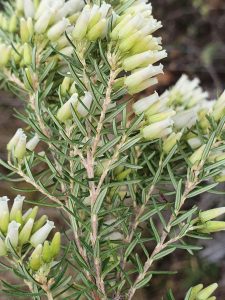
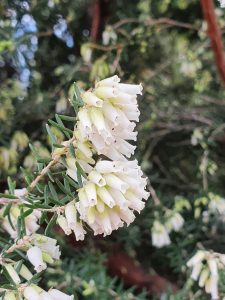
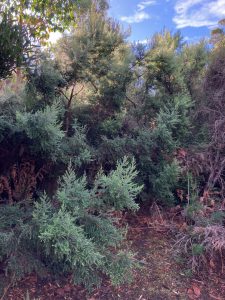
Impacts?
Water heath is a fast-growing plant and can establish in relatively natural ecosystems. It is tolerant of a wide range of conditions including frost, fire, waterlogging, and possibly drought. Without control, water heath can spread rapidly and cause devastation to waterways and surrounding habitats. It poses a very high risk to biodiversity because of its ability to form dense thickets that smother native vegetation, as well as prevent access for land management and recreational activities. Dense infestations of water heath pose a significant fire hazard.
Where are you likely to see it?
Water heath has a limited distribution and is currently restricted to small areas on South Bruny.
If you see water heath, please report these sightings to Kingborough Council.

Methods of control?
By hand
Seedlings and small plants can be hand pulled in moist or sandy soil. Take care when removing by hand, as plants break off easily and remaining roots can reshoot. Plants should be left on site to break down.
Cut stump method
Cut stems as low to the ground as possible and paint undiluted Glyphosate herbicide on the stump within 15 seconds.
Foliar spraying
Foliar spraying can be highly effective, providing it is carefully chosen, selectively applied to small plants and regrowth, and all foliage is covered when the herbicide is applied.
Several herbicides are effective on water heath including Metsulfuron-methyl (eg. Associate), which is of very low toxicity. The addition of a wetting agent or penetrant will improve the uptake of any herbicide used.
What is being done about water heath?
Water heath is a high priority weed which is targeted throughout Kingborough. In working towards this, Council uses a number of control methods, including cut and paint, targeted spraying and manual removal.
Water heath mostly occurs on private land, but like all weeds, it has no regard for property boundaries, routinely jumping from one property to the next. In recognition of the potential impacts of this invasive species, Kingborough Council secured funding through the Weed Action Fund for a 3 year, cross-tenure weed control project on Bruny Island.
Council staff have extensively surveyed areas around known infestations of water heath and identified private properties for free weed control assistance through the grant funding. Infestations of water heath were prioritised to ensure the most cost effective and efficient use of the limited amount of funding.
Prioritisation is based on a number of factors, such as size of infestations, proximity to areas of high natural values including threatened species, and other criteria, such as impact on fire regime, recreational or aesthetic values.
The opportunity to work collaboratively with private landowners has been important to the success of the Weed Action Fund project and achieving the long-term goal of eradicating water heath from Kingborough.
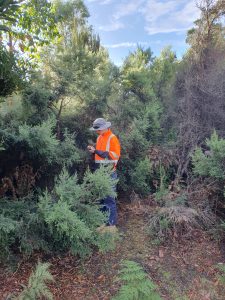
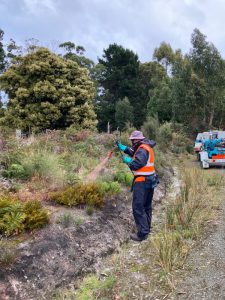
For more information about Paterson’s Curse and removing it using herbicides, visit Department of Primary Industries, Parks, Water and Environment’s website: Erica | Department of Natural Resources and Environment Tasmania (nre.tas.gov.au)
KC WEED OF THE MONTH - OCTOBER - PATERSON'S CURSE
Click to download information flyer –> 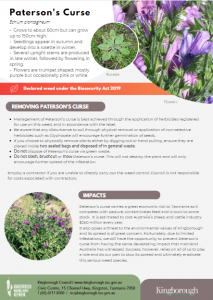
Name of weed?
Echium plantagineum (Paterson’s Curse)
Status
Declared weed under the Biosecurity Act 2019
CHARACTERISTICS OF PATERSON’S CURSE
What does it look like?
- Paterson’s curse commonly grows to 60cm high, but it can grow up to 150cm.
- Seedlings appear in autumn and develop into a rosette in winter.
- Several upright stems are produced in late winter, followed by flowering in spring.
- Flowers are trumpet shaped; mostly purple but occasionally pink or white.
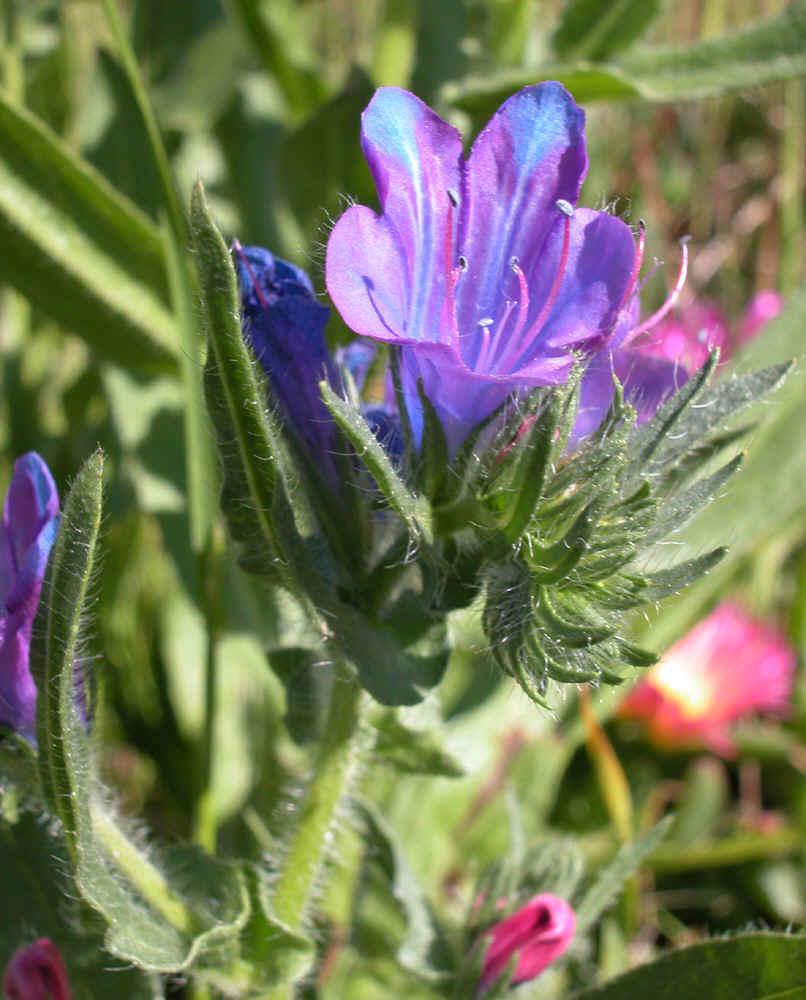
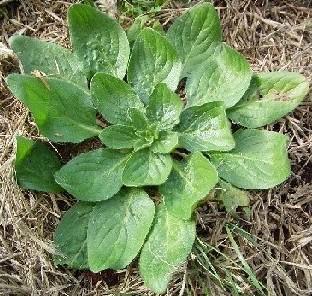
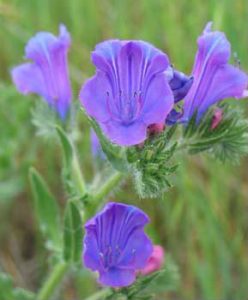
Impacts?
Paterson’s curse carries a great economic risk to Tasmania as it competes with pasture, contaminates feed and is toxic to some stock. It is estimated to cost Australia’s sheep and cattle industry $250 million every year. It also poses a threat to the environmental values of Kingborough and its spread is of great concern. Fortunately, due to limited infestations, we still have the opportunity to prevent Paterson’s curse from having the same devastating impact that mainland Australia has witnessed. Success, however, relies on all of us to play a role and do our part to stop its spread and ultimately eradicate this serious weed species.
How does it spread?
Paterson’s curse reproduces by seed which can be spread via:
- Vehicles and machinery
- Water
- Animals (livestock, birds, ants)
- On clothing and footwear
- In hay, sileage, wool, soil, and commercial seed
- Livestock can carry seed in their digestive tract or directly on their coats.
Where are you likely to see it?
Paterson’s curse is most likely to be encountered in the Suncoast area of Blackmans Bay, however scattered infestations occur elsewhere in Kingborough.
If you see Paterson’s curse, please report these sightings to Kingborough Council.
Methods of control?
- Management of Paterson’s curse is best achieved through the application of herbicides registered for use on this weed, and in accordance with the label.
- Be aware that any disturbance to soil through physical removal or application of non-selective herbicides such as Glyphosate will encourage further germination of seeds.
- If you choose to physically remove plants either by digging out or hand pulling, ensure they are placed inside two sealed bags and disposed of in general waste.
- Do not dispose of Paterson’s curse via green waste.
- Do not slash, brushcut or mow Paterson’s curse. This will not destroy the plant and will only encourage further spread of the infestation.
What is being done about Paterson’s curse?
Paterson’s curse is a high priority weed which is targeted throughout Kingborough. In working towards this, Council uses a number of control methods, including cut and paint, targeted spraying and manual removal.
Flowering occurs mostly in Spring, but as plants of Paterson’s curse can be found at any time of the year in all stages of growth, Council staff visit all known infestations on Council land regularly throughout year and control any plants detected.
Since 2017, Council has sent letters each Spring to all residents in the area of any known Paterson’s curse infestation as a reminder to re-inspect their property, remain watchful over the coming months and to control any plants found, including following up any previous work as required.
When Paterson’s curse is identified on other land tenures, including private land, landowners are notified and advised of best practice control methods. Where necessary, Council will enforce the Biosecurity Act 2019 and require landowners to control Paterson’s curse infestations.
Kingborough Council has fined landowners in the municipality for failing to comply with a requirement notice in relation to Paterson’s curse.
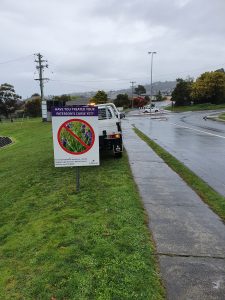
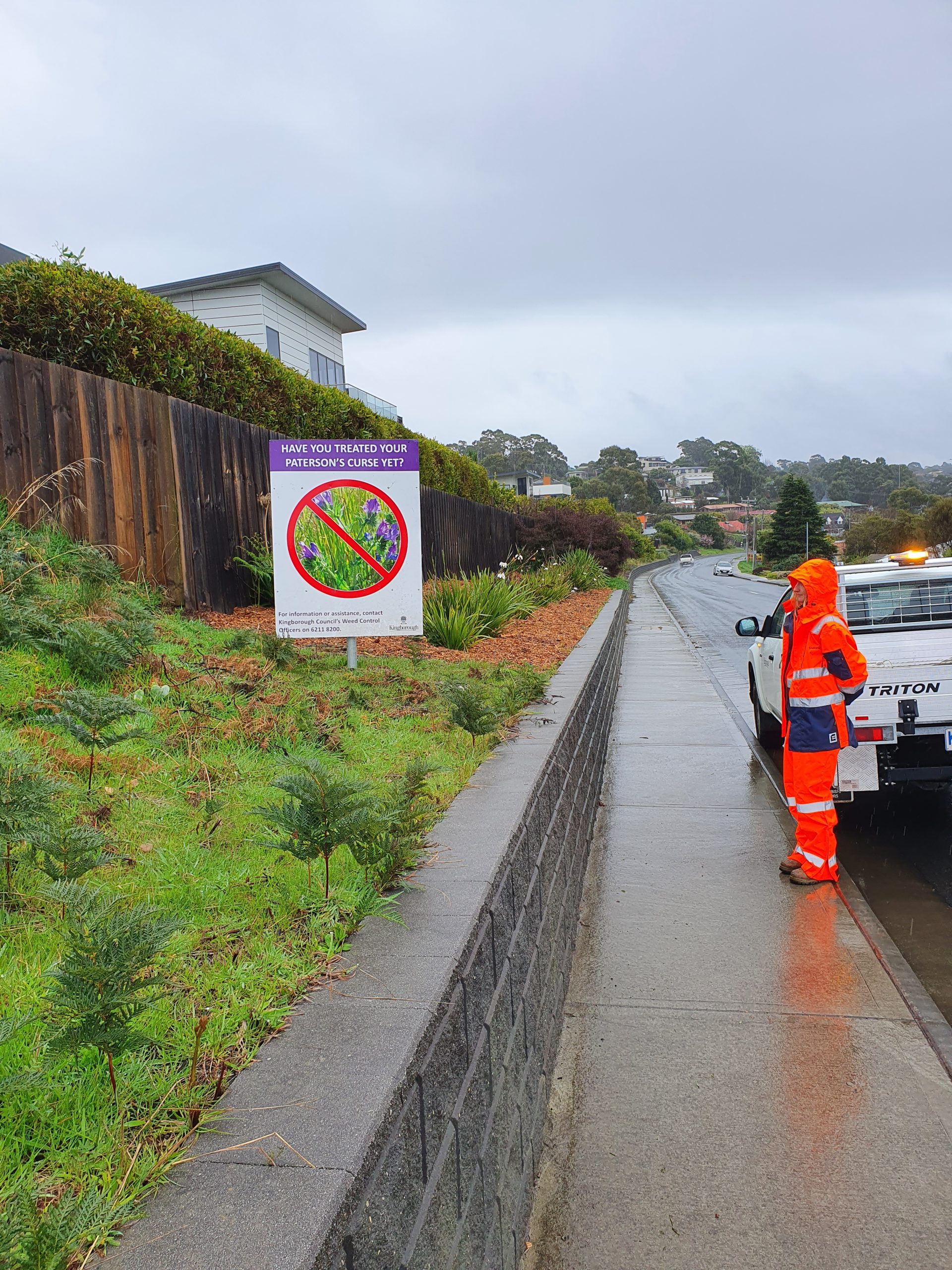
For more information about Paterson’s Curse, visit Department of Natural Resource and Environment Tasmania website: Paterson’s Curse and Viper’s Bugloss | Department of Natural Resources and Environment Tasmania (nre.tas.gov.au)
KC WEED OF THE MONTH - NOVEMBER - SERRATED TUSSOCK
Click to download information 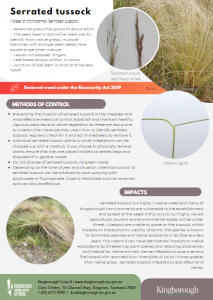 flyer –>
flyer –>
Name of weed?
Nassella trichotoma (Serrated tussock)
Status
Declared weed under the Biosecurity Act 2019
CHARACTERISTICS OF SERRATED TUSSOCK
What does it look like?
- Serrated tussock is a perennial grass to about 50cm high.
- The seed head is distinctive and is the best way to identify serrated tussock.
- Leaf blades have a rough or serrated texture, and while useful in distinguishing this species, is not in itself diagnostic.
- Serrated tussock leaves roll smoothly between the fingers as if cylindrical. Similar looking native grasses feel like they have flat edges.
- Leaf bases of serrated tussock are always whitish in colour, never purple.
- At the junction of the leaf and stem of serrated tussock is a short, hairless ligule. Most grasses that are confused with serrated tussock have hairy ligules.
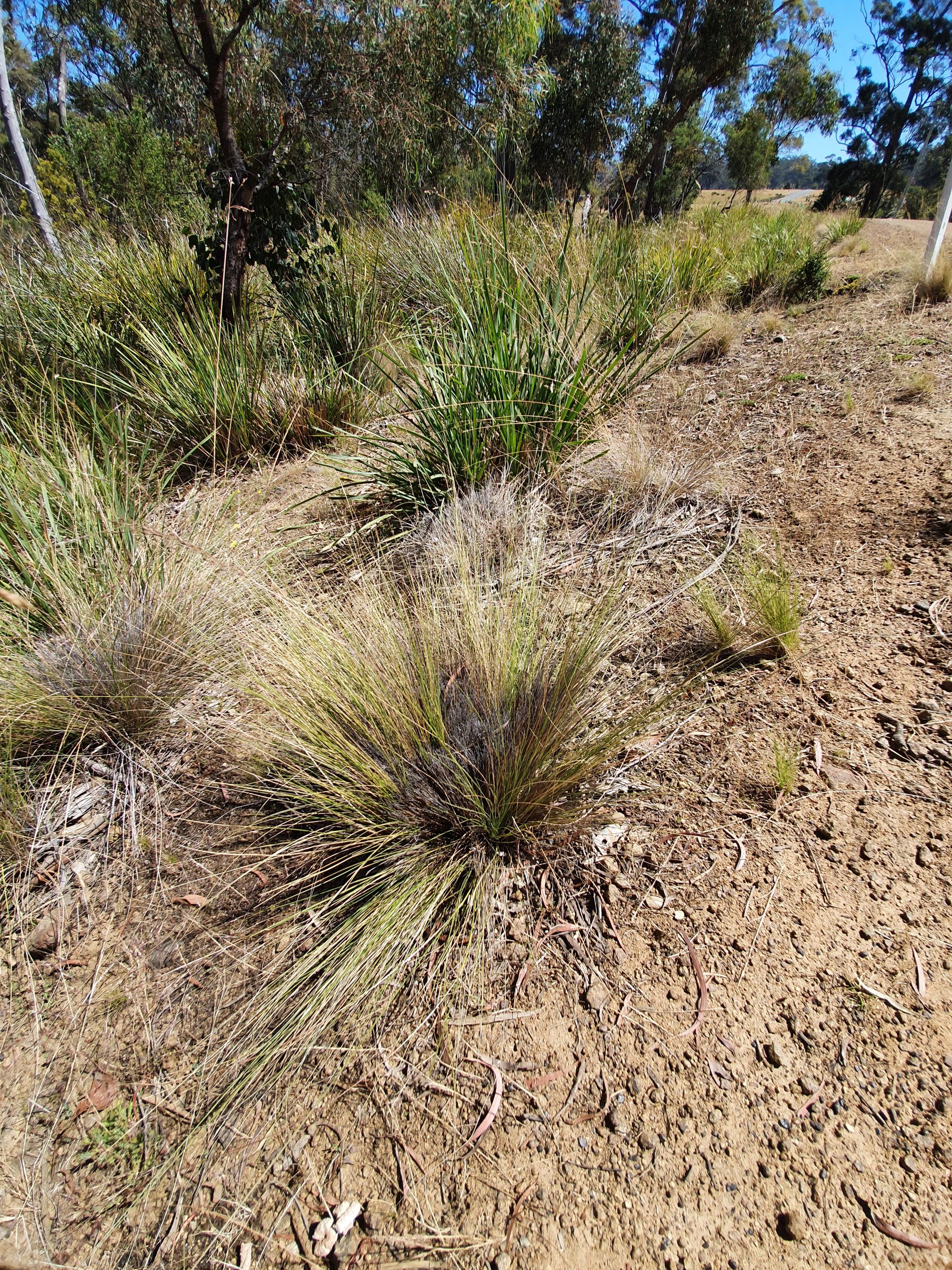
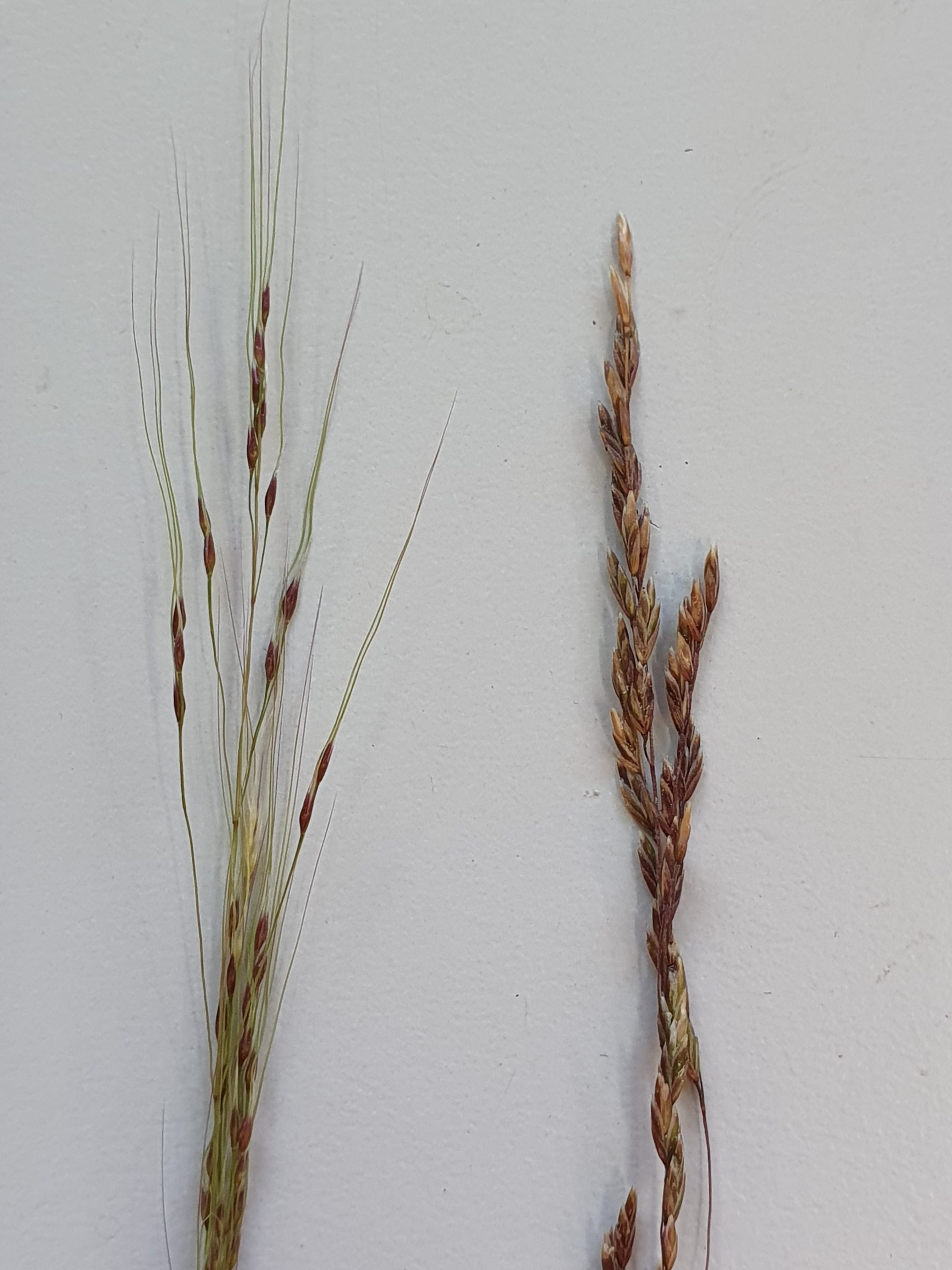
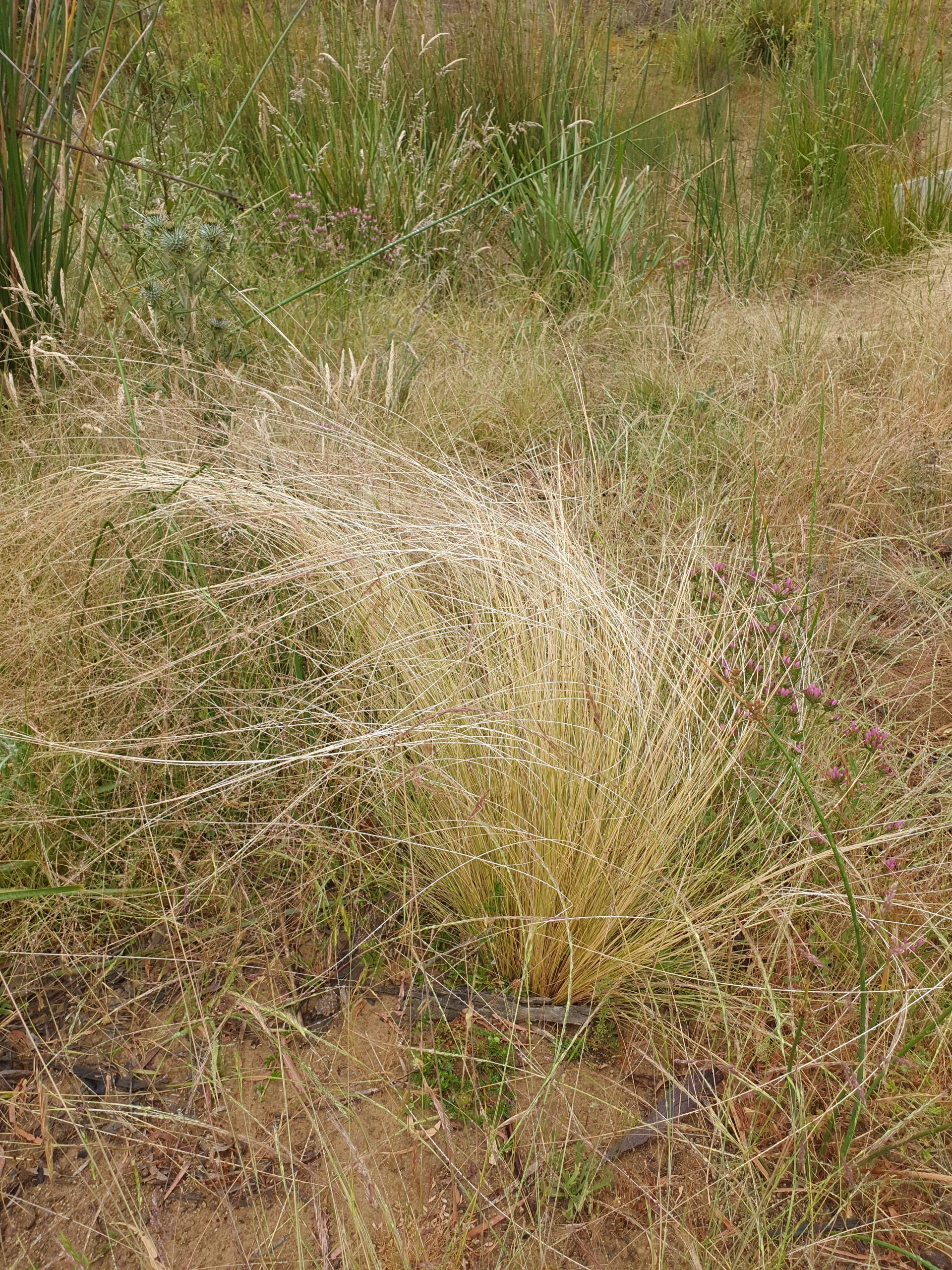
Why is it a problem?
Serrated tussock is a highly invasive weed and many of Kingborough’s environments are vulnerable to the establishment and spread of the weed. If this occurs, our highly valued agricultural, tourism and environmental assets will be under threat. Livestock are unable to graze on the tussock, which impacts on the economic viability of farms. The species is known to dominate pastures and native grasslands in as little as a few years. This means it can have detrimental impacts on native ecosystems by threatening plant species and reducing biodiversity and habitat for native animals. Dense infestations pose a serious fire hazard with recorded burn intensities of up to 7 times greater than native grass. Serrated tussock infestations also affect land values.
How does it spread?
Serrated tussock grows from seed, which is mainly spread by wind. Seed heads are carried along the ground and in the air and may be blown many kilometres.
Serrated tussock seeds are also dispersed by:
- moving water
- transportation of soil, gravel, and firewood
- in hay and fodder
- on machinery and equipment
- coats of livestock
- in the droppings of animals.
Where are you likely to see it?
A limited number of small, localised occurrences have been recorded across Kingborough. These are the result of accidental importation of seed in hay, soil, and gravel, or during activities such as earthworks, and mowing.
If you are planning to use a contractor to undertake landscaping or building activities, demand their vehicles, machinery, and equipment has been washed down before entering your property, especially if they work regularly in areas known to have large infestations of serrated tussock, such as Hobart’s Eastern Shore. If they have not washed down, do not let them enter your property. Direct them to https://nre.tas.gov.au/Documents/Washdown-Guidelines-Edition-1.pdf, where they will find the appropriate washdown directions for various equipment, and the associated washdown ledger. Once this has been completed, then work on your property can commence. This is a legal obligation of the contractor.
Likewise, avoid buying products such as soil, gravel, and hay from contaminated areas. Wherever possible buy certified weed-free products.
If you see serrated tussock, please report these sightings to Kingborough Council.

Methods of control?
- Preventing the invasion of serrated tussock is the cheapest and most effective means of control. Establish and maintain healthy, vigorous pastures and native vegetation as these are less prone to invasion than bare patches. Learn how to identify serrated tussock, regularly check for it and act immediately to remove it.
- Individual serrated tussock plants or small infestations can be chipped out with a mattock. If you choose to physically remove plants, ensure that they are placed inside two sealed bags and disposed of in general waste.
- Do not dispose of serrated tussock via green waste.
- Depending on the time of year and situation, chemical control of serrated tussock can be achieved by spot spraying with glyphosate or flupropanate. Organic herbicides such as nonanoic acid can also be effective.
What is being done about serrated tussock?
Serrated tussock is a high priority weed which is targeted throughout Kingborough. In working towards this, Council uses a number of control methods, including targeted spraying and manual removal.
Council staff visit all known infestations on Council land regularly throughout year and control any plants detected.
In early 2022, a significant roadside infestation of serrated tussock was discovered at Apollo Bay on Bruny Island. The environment and land uses of North Bruny make it particularly vulnerable to the establishment and spread of serrated tussock. Council immediately created a management zone for Apollo Bay to contain the infestation. This included a temporary halting of roadside slashing and Council earth works in the area, installation of signage, engagement of surrounding property owners, conducting a community information session, and funding a cross-tenure eradication program.
The eradication program includes free surveying of private land using Council staff and Fonzie the conservation detection dog to sniff out isolated plants missed during primary control. Remaining serrated tussock plants were manually removed.
A single serrated tussock plant can produce over 100,000 seeds each year and often the presence of the weed is not known before infestations are widespread and are causing significant impacts. The use of the conservation detection dog is critical in locating isolated serrated tussock plants in a landscape dominated by similar-looking native tussock grasses.
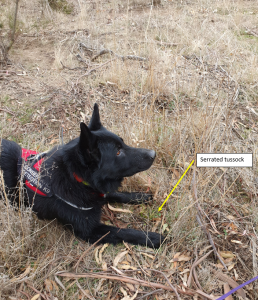
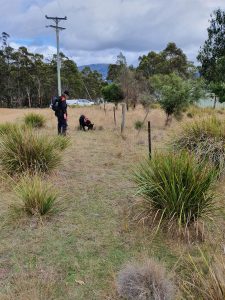

For more information about serrated tussock, visit Department of Natural Resource and Environment Tasmania website:
https://nre.tas.gov.au/invasive-species/weeds/weeds-index/declared-weeds-index/serrated-tussock
KC WEED OF THE MONTH - DECEMBER - RAGWORT
Click to download information flyer –>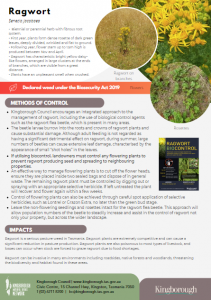
Name of weed?
Senecio jacobaea (Ragwort)
Status
Declared weed under the Biosecurity Act 2019
CHARACTERISTICS OF RAGWORT
What does it look like?
- Ragwort is a biennial or perennial herb with a fibrous root system.
- In the first year of growth, plants form a dense rosette of dark green leaves which are deeply divided, wrinkled, and flat to the ground.
- The following year, a flower stem up to 1.5 m high is produced between November and April.
- Ragwort has characteristic bright yellow daisy-like flowers, arranged in large clusters at the ends of branches, which are visible from a great distance.
- Plants have an unpleasant smell when crushed.
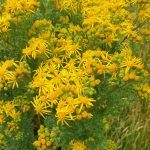
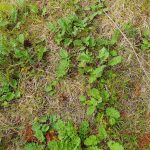
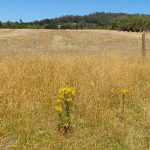
Why is it a problem?
Ragwort is a serious pasture weed in Tasmania. Ragwort plants are extremely competitive and can cause a significant reduction in pasture production. Ragwort plants are also poisonous to most types of livestock, and losses can occur when stock are forced to graze ragwort due to food shortages.
Ragwort can be invasive in many environments including roadsides, native forests and woodlands, threatening the biodiversity and habitat found in these areas.
How does it spread?
Spread of ragwort is mostly by seed, however it can reproduce vegetatively from root fragments. Most seeds are deposited within 20 metres of the parent plant but may disperse up to a kilometre, or more, by strong winds. Seed is also spread in the coats of animals, by water, in stock feed, or in mud attached to vehicles and machinery. Ragwort seed can remain viable in the soil for up to 16 years.
Where are you likely to see it?
Small infestations of ragwort can be found across Kingborough; however Bruny Island is known to be a hotspot for the species within the municipality.
Methods of control?
- Kingborough Council encourages an integrated approach to the management of ragwort, including the use of biological control agents such as the ragwort flea beetle, which is present in many areas.
- The beetle larvae burrow into the roots and crowns of ragwort plants and cause substantial damage. Although adult feeding is not regarded as having a significant detrimental effect on ragwort, during summer, large numbers of beetles can cause extensive leaf damage, characterised by the appearance of small “shot holes” in the leaves.
- If utilising biocontrol, landowners must control any flowering plants to prevent ragwort producing seed and spreading to neighbouring properties.
- An effective way to manage flowering plants is to cut off the flower heads, ensure they are placed inside two sealed bags and dispose of in general waste. The remaining ragwort plant must be controlled by digging out or spraying with an appropriate selective herbicide. If left untreated the plant will recover and flower again within a few weeks.
- Control of flowering plants can also be achieved through careful spot application of selective herbicides, such as Lontrel or Grazon Extra, no later than the green bud stage.
- Leave the non-flowering seedlings and rosettes intact for the ragwort flea beetle. This approach will allow population numbers of the beetle to steadily increase and assist in the control of ragwort not only your property, but across the wider landscape.
What is being done about ragwort?
Ragwort is controlled on Council-owned reserves and roadsides, using an integrated approach of biological control and manual removal of flowering plants. In working towards this, Council staff visit known ragwort areas multiple times during summer to early autumn. Ragwort flowering is staggered steadily across the ragwort season, therefore it is possible that flowering plants will be clearly visible in between visits by Council staff.
Kingborough Council has provided landowners on Bruny Island with a free ragwort disposal service since 2006. Council remains committed to assisting the Bruny community with the disposal of plants that have been physically removed from their properties. This is a service for which there is no obligation to provide and comes at a cost to Council. Ragwort is the only weed where Council provides such a service, and the effectiveness and value of this service will continue to be monitored.
For more information regarding the cost analysis of the disposal program, or any other matters addressed within the review of Council’s Bruny Island Ragwort Program, visit the link listed below.
Council also continues to work with the community, providing education resources and technical advice, including how to utilise effective integrated weed control when managing ragwort. This includes community education sessions, social media campaigns and roadside signage.
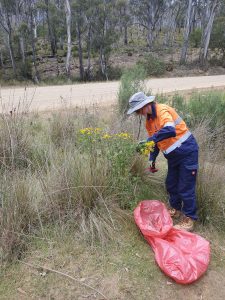
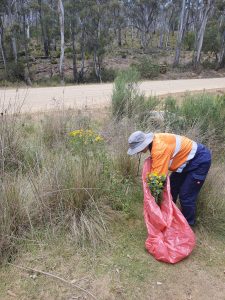
Request for compliance: Many ragwort infestations are privately owned, and this is a source of frustration for neighbouring properties who have been actively controlling ragwort. The quickest and most effective way of dealing with any issue on an adjacent property is to foster good relations with your neighbour and seek to resolve the issues together. However, if approaching your neighbour is not possible or proves ineffective, you can request compliance support from Council for the removal of ragwort. Council’s authorised weed officers have delegations from the State which enable them to require landowners undertake certain actions under the Biosecurity Act 2019. Read the information sheet on our website and submit your request for compliance support via our online form.
Request for compliance support
https://www.kingborough.tas.gov.au/services/20844-2/weeds/
An independent evaluation of the effectiveness and efficiency of Kingborough Council’s ragwort management practices on Bruny Island
Kingborough Council’s Bruny Island Ragwort Program Review and Action Plan
Flea beetle information
https://biocollect.ala.org.au/document/download/2018-02/Ragwort%20flea%20beetle%20factsheet.PDF
Further info on ragwort
https://nre.tas.gov.au/invasive-species/weeds/weeds-index/declared-weeds-index/ragwort
KC WEED OF THE MONTH - JANUARY - KARAMU
Click to download information flyer –> 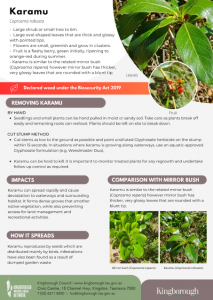
Name of weed?
Coprosma robusta (Karamu)
Status
Declared weed under the Biosecurity Act 2019
CHARACTERISTICS OF KARAMU
What does it look like?
- Karamu is a large shrub or small tree to 6 metres high.
- It has large oval-shaped leaves that are thick and glossy with pointed tips.
- Flowers are small, greenish and grow in clusters.
- Fruit is a fleshy berry, green initially, ripening to orange-red during summer.
- Karamu is similar to the related mirror bush (Coprosma repens)however mirror bush has thicker, very glossy leaves that are rounded with a blunt tip.
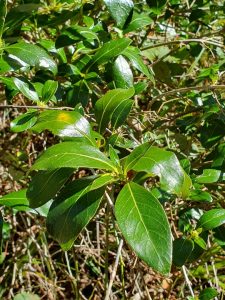
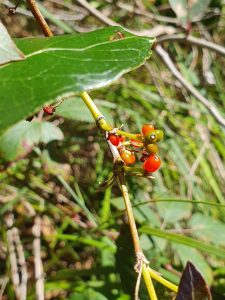
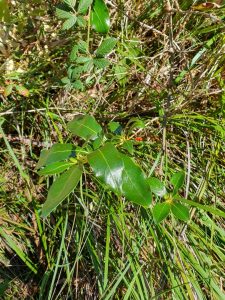
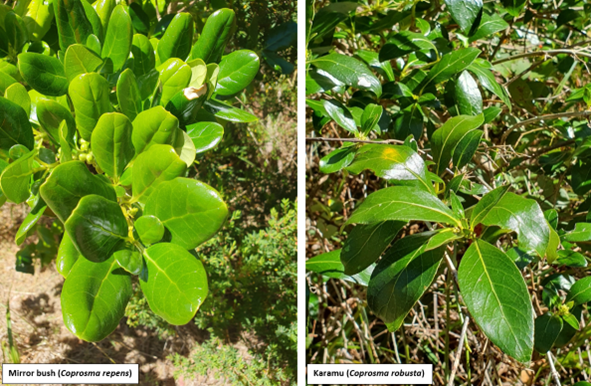
Why is it a problem?
Karamu can spread rapidly and cause devastation to waterways and surrounding habitats. It can form dense thickets that smother native vegetation as well as prevent access for land management and recreational activities.
How does it spread?
Karamu reproduces by seed, which is dispersed mainly by birds, as well as in dumped garden waste.
Where are you likely to see it?
Small, localised populations of karamu have been recorded near Kaoota, Middleton, and along the banks of Browns River.
If you see karamu, please report these sightings to Kingborough Council.
Methods of control?
By hand
Seedlings and small plants can be hand pulled in moist or sandy soil. Take care as plants break off easily and remaining roots can reshoot. Plants should be left on site to break down.
Cut stump method
Cut stems as low to the ground as possible and paint neat Glyphosate herbicide on the stump within 15 seconds. In situations where karamu is growing along waterways, use an aquatic-approved Glyphosate formulation (e.g. Weedmaster Duo).
Karamu can be hard to kill, therefore it is important to monitor treated plants for any regrowth and undertake follow up control as required.
What is being done about the weed?
Karamu is a weed which is targeted throughout Kingborough. In working towards this, Council uses a number of control methods including cut and paint, and manual removal.
Karamu mostly occurs on private land but like all weeds, it has no regard for property boundaries, routinely jumping from one property to the next. In recognition of the potential impacts of this invasive species, Kingborough Council in partnership with the Derwent Catchment Project and other stakeholders, secured funding through the Weed Action Fund for a 3 year, cross-tenure karamu control project.
Council staff extensively surveyed areas around known infestations of karamu and identified private properties for free weed control through the grant funding. Infestations of karamu were prioritised to ensure the most cost effective and efficient use of the limited amount of funding.
Prioritisation is based on a number of factors, such as the size of infestations, proximity to areas of high natural values, such as threatened species, and other criteria, such as impact on fire regime, recreational or aesthetic values.
The opportunity to work collaboratively with private landowners has been important to the success of the Weed Action Fund project and achieving the long-term goal of eradicating karamu from Kingborough.
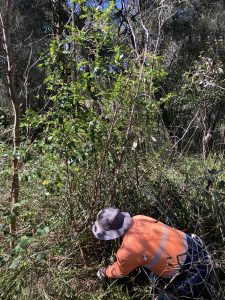
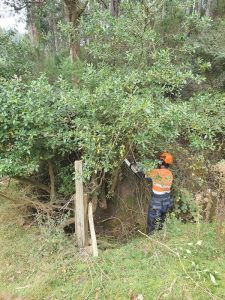
For more information about karamu, visit Department of Natural Resource and Environment Tasmania website: https://nre.tas.gov.au/invasive-species/weeds/weeds-index/declared-weeds-index/karamu
KC WEED OF THE MONTH - FEBRUARY - HEATHER
Click to download information flyer –> 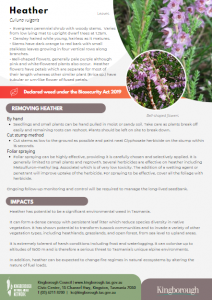
Name of weed
Calluna vulgaris (heather)
Status?
Declared Weed under the Biosecurity Act 2019
What does it look like?
- Heather is an evergreen perennial shrub with woody stems. Its growth habit varies from a low-lying mat through to upright dwarf trees 1.25 metres tall.
- Young growth is initially densely hairy, but the plant becomes hairless as it matures. The stems have dark orange to red bark. Small, stalkless leaves grow in four vertical rows along the branches. The leaves are initially dark green and later turn brown.
- Heather has bell-shaped flowers, generally pale purple although pink and white-flowered plants also occur. Heather flowers have petals which are separate for most of their length, whereas other similar plants (eg. Ericaspecies) have a tubular or urn-like flower of fused petals.
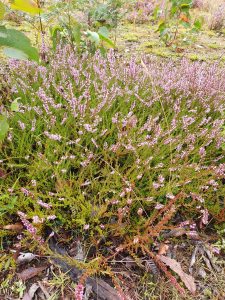
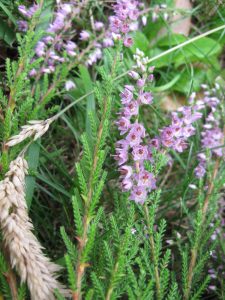
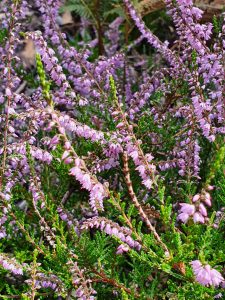
Why is it a problem?
Heather has potential to be a significant environmental weed in Tasmania.
It can form a dense canopy with persistent leaf litter which reduces diversity in native vegetation. It has shown potential to transform tussock communities and to invade a variety of other vegetation types, including heathlands, grasslands, and open forest, from sea level to upland areas.
It is extremely tolerant of harsh conditions including frost and waterlogging. It can colonise up to altitudes of 1500 m and is therefore a serious threat to Tasmania’s unique alpine environments.
In addition, heather can be expected to change fire regimes in natural ecosystems by altering the nature of fuel loads.
How does it spread?
Heather spreads primarily by seed.
Mature plants can produce many hundreds of thousands of seeds per year, which are easily transported over large distances by wind and running water. People, vehicles, machinery, and animals can also spread seeds along roads and walking tracks. Seeds remain viable for long periods, possibly for over 100 years.
Heather is also capable of reproducing by stem , and there is some suggestion that root fragments may also give rise to new plants.
Where are you likely to see it?
Heather has a limited distribution and is currently restricted to very small areas near Kingston and Lunawanna.
If you see heather, please report these sightings to Kingborough Council.
Methods of control?
By hand
Seedlings and small plants can be hand pulled in moist or sandy soil. Take care as plants break off easily and remaining roots can reshoot. Plants should be left on site to break down.
Cut stump method
Cut stems as low to the ground as possible and paint undiluted Glyphosate herbicide on the stump within 15 seconds.
Foliar spraying
Foliar spraying can be highly effective, providing it is carefully chosen and selectively applied. It is generally limited to small plants and regrowth. Several herbicides are effective on heather including Metsulfuron-methyl (eg. Associate) which is of very low toxicity. The addition of a wetting agent or penetrant will improve uptake of the herbicide. For spraying to be effective, cover all the foliage with herbicide.
Ongoing follow-up monitoring and control will be required to manage the long-lived seedbank.
What is being done about the weed?
Heather is a high priority weed which is targeted throughout Kingborough. In working towards this, Council uses a number of control methods, including targeted spraying and manual removal. Council staff visit all known infestations on Council land regularly throughout year and control any plants detected.
When heather is identified on other land tenures, including private land, landowners are notified and advised of best practice control methods. Where necessary, Council will enforce the Biosecurity Act 2019 and require landowners to control heather infestations.
For more information about heather, visit Department of Natural Resource and Environment Tasmania website: https://nre.tas.gov.au/invasive-species/weeds/weeds-index/declared-weeds-index/heather
KC WEED OF THE MONTH - MARCH - PAMPAS
Click to download information flyer –> 
Name of weed?
Pampas (Cortaderia species)
Status
Declared Weed under the Biosecurity Act 2019
What does it look like?
- Two species of pampas are found in Kingborough: Cortaderia selloana (common pampas grass) and Cortaderia jubata (pink pampas grass). Their features are similar, so for practical purposes they are treated as one weed and collectively referred to as ‘pampas’
- Pampas are large, perennial, tussock-forming grasses growing to over 2 metres high.
- Leaves are finely serrated on the edges, bright green, with a prominent central vein. Dead leaves at the base of the plant spiral like wood shavings.
- Dense, fluffy, white, or pink flowerheads extend well above the height of the tussock.
- Pink pampas grass flowers from January to late March, whereas common pampas grass flowers from mid-March to late May.



Why is it a problem?
Pampas can rapidly invade a range of vegetation types from coastal scrub to closed wet forest, where it readily outcompetes native vegetation. This highly invasive species is problematic for many industries such as forestry and communication networks, and can make access along roads, walking tracks and recreation areas difficult. In the wider landscape, pampas is highly flammable and poses a significant fire hazard.
How does it spread?
Pampas reproduce mainly by seed, producing large quantities that can be windblown for distances of up to 25 km. Plants can produce up to 100, 000 seeds per flower head, with each plant producing multiple flower spikes.
Pampas can also reproduce from root fragments when moved on dirty equipment during cultivation, or when pampas material is dumped in green waste and allowed to regrow.
Where are you likely to see it?
Small, localised occurrences have been recorded across Kingborough; however Electrona is known to be a hotspot for pampas within the municipality.
If you see pampas in Kingborough, please report the sighting to Council.
Methods of control?
- Small pampas can be removed manually by hand-pulling or digging out the entire plant with a mattock. Ensure all root material is removed otherwise regrowth may occur.
- Manually removed pampas can be left upside down with roots exposed to die.
- To prevent the spread of seed, remove any flowerheads and ensure they are placed inside two sealed bags and disposed of in general waste.
- Do not dispose of pampas via green waste.
- Larger plants can be slashed, and the regrowth treated with herbicide.
- Chemical control of pampas can be achieved by application of glyphosate-based herbicides. As glyphosate is non-selective, application of grass-selective herbicides (eg. Fusilade) for pampas growing in bushland amongst native shrubs may be more appropriate.
What is being done about the weed?
Pampas is a high priority weed which is targeted throughout Kingborough. In working towards this, Council uses a number of control methods, including targeted spraying and manual removal. Council staff visit all known infestations on Council land regularly throughout year and control any plants detected.
When pampas are identified on other land tenures, including private land, landowners are notified and advised of best practice control methods. Where necessary, Council will enforce the Biosecurity Act 2019 and require landowners to control pampas infestations.


For more information about pampas, visit Department of Natural Resource and Environment Tasmania website: https://nre.tas.gov.au/invasive-species/weeds/weeds-index/declared-weeds-index/pampas
KC WEED OF THE MONTH - APRIL - STINKWORT
Click here to download information flyer –>
Name of weed
Stinkwort (Dittrichia graveolens)
Status?
Non-declared weed in Tasmania
What does it look like?
- Stinkwort is an erect, multi-branched, annual plant.
- It commonly grows to 50 cm high but can occasionally grow taller.
- Light grey to green coloured leaves, up to 4 cm long, are widely spaced along the stems.
- The whole plant is sticky to touch, and strongly aromatic with a camphor-like smell.
- Small yellow daisy flowers are produced in late summer and autumn.
- Fleabane (Conyza species) are similar in appearance but can be distinguished from stinkwort by their smaller white flowers lacking obvious petals, and absence of any sticky aromatic oils when handled.
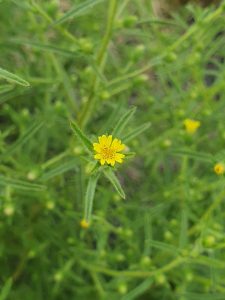
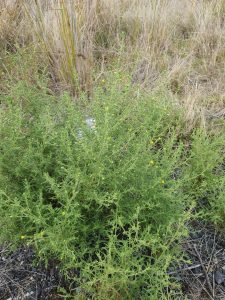
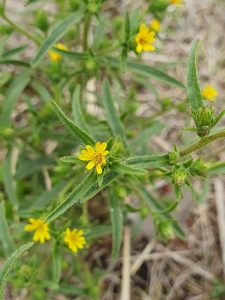
Why is it a problem?
- Livestock that eat the flowerheads can develop enteritis (inflammation of the small intestine) since the seed irritates and punctures the lining of the small intestine, eventually leading to pulpy kidney disease and sudden death, if untreated.
- While grazing animals appear to find stinkwort unpalatable, they will eat the plant only when little else is available. This often occurs in late summer and autumn coinciding with the stinkwort flowering period.
- The leaves contain an oil that can cause severe dermatitis in humans especially if handled when in flower.
- Stinkwort is mainly a weed of agricultural areas, but it can invade dry coastal vegetation, lowland grassland, and grassy woodland where it has the potential to negatively affect native ground cover species.
How does it spread?
Stinkwort reproduces from seed, which is dispersed by wind, water, agricultural produce, machinery, vehicles, and wool.
An individual stinkwort plant can produce up to 15,000 seeds.
Seeds can survive in the soil for up to 3 years.
Where are you likely to see it?
Within Kingborough, stinkwort is only known from very small infestations at Electrona and Dennes Point.
If you see stinkwort, please report these sightings to Kingborough Council.
Methods of control?
By hand
- Isolated plants can be hand pulled before flowering and left on site to break down. Plants in flower should be removed from site as seed will develop from the nutrient reserves in the stem if left on the ground.
- Ensure flowering stinkwort are placed inside two sealed bags and disposed of in general waste. Do not dispose of stinkwort via green waste.
- Remember to wear gloves when handling the plant as some people are quite sensitive and it may take several months for the dermatitis to clear.
Chemical
- The sticky oils on the foliage can make it difficult to control stinkwort with herbicides. However, selective herbicides containing Triclopyr (eg. Garlon) are effective if applied before flowering.
Mechanical
- Large areas can be mowed or slashed before flowering, but this is effective only if plants are cut very close to the ground. Repeat treatment of regrowth may be needed a few weeks later.
Competition and management
- Stinkwort establishes and thrives in open, disturbed sites. To limit its chances for establishing, minimise disturbances such as overgrazing and soil manipulation. Pastures should be managed for dense, competitive stands. Aim for maximum ground cover in spring when stinkwort seedlings are trying to establish.
What is being done about the weed?
Stinkwort is controlled on Council-owned reserves and roadsides, using several methods, including targeted spraying and manual removal of flowering plants. In working towards this, Council staff visit known stinkwort areas multiple times during summer and autumn.
Whilst stinkwort is a non-declared weed in Tasmania, it presents a significant biosecurity risk to the agricultural sector and the natural environment. The Biosecurity Act 2019 introduces in Tasmania a new legal obligation known as the general biosecurity duty (GBD) which emphasises the importance of shared responsibilities and the need for Government, industry, and the community to work together to maintain a strong biosecurity system. In simple terms, the GBD reinforces that everyone has a role to play in protecting our unique environment and primary industries against biosecurity risks.
Stinkwort has a very limited distribution in southern Tasmania and should be prevented from continuing its spread.

